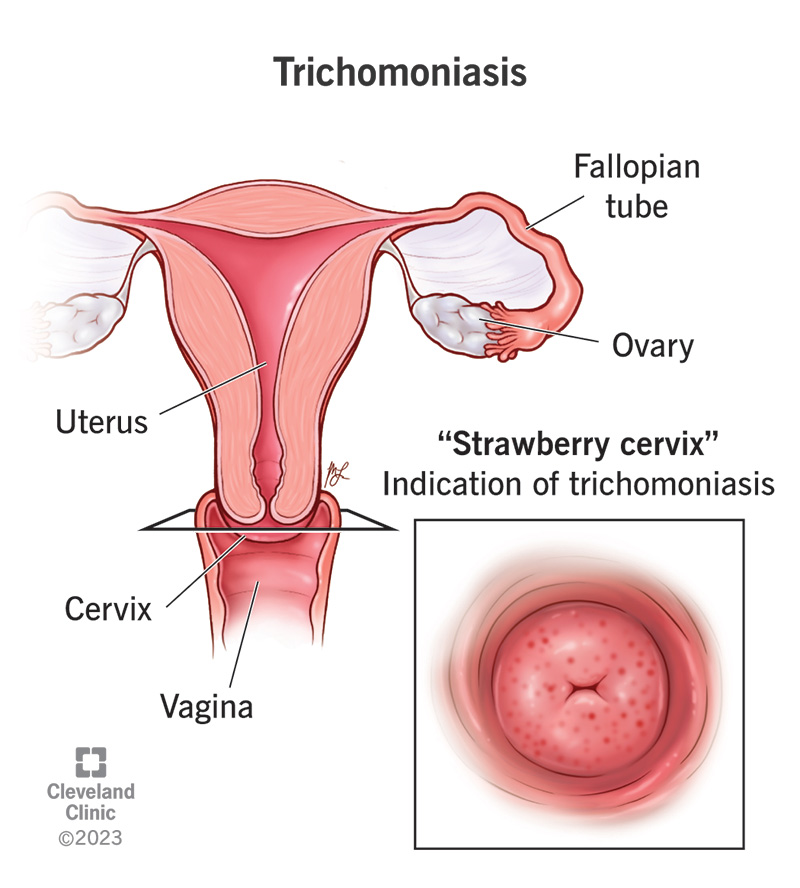Trichomoniasis (trich) is a common, but curable, sexually transmitted infection (STI). A parasite causes trich. Most people who have trich don’t have symptoms. Treatment for trich involves taking antibiotics.
Advertisement
Cleveland Clinic is a non-profit academic medical center. Advertising on our site helps support our mission. We do not endorse non-Cleveland Clinic products or services. Policy

Trichomoniasis or “trich” is a common and curable sexually transmitted infection (STI). Trich spreads during sexual intercourse — in semen (cum) and vaginal fluids. Its name comes from the parasite Trichomonas vaginalis, which causes the infection.
Advertisement
Cleveland Clinic is a non-profit academic medical center. Advertising on our site helps support our mission. We do not endorse non-Cleveland Clinic products or services. Policy
You may have trich and not know it — most people don’t have symptoms from the infection. Trich is contagious, which means you might unknowingly infect others through sexual contact.
It’s the most common nonviral sexually transmitted infection globally. Anyone who has sex can get trich. Approximately 3.7 million people have the infection in the United States. Only about 30% of people have symptoms. Trichomoniasis is more common in Black women.
One reason trich spreads so easily is that a large number of infected people — up to 70% — never have symptoms. You may infect others before you know you have the disease. When symptoms occur, they tend to appear within five to 28 days after exposure. Symptoms are more common in women. Researchers aren’t entirely sure why some people have symptoms and others don’t.
Men rarely show signs of infection. In those who do, the most common are:
Women tend to have more noticeable symptoms than men. Some of them are:
Advertisement
A small parasite called Trichomonas vaginalis causes trich. Once you have the infection, you can give trich to someone else through:
You can’t spread trich by sharing food and drinks, kissing, holding hands or through other nonsexual forms of contact.
In addition to affecting your genitals, trich can also infect your anus, mouth and hands.
No. Poor hygiene won’t cause trichomoniasis. A parasite causes trich. The parasite spreads from partner to partner during sexual contact.
No, a urinary tract infection (UTI) doesn’t cause trichomoniasis.
Yes, trich is contagious. Many people aren’t aware they have it and unknowingly spread it to their sexual partners.
Trich can affect anyone. Women are more likely to get trich. Your risk for trich increases if you:
Untreated trich increases your risk of becoming infected with the human immunodeficiency virus (HIV) if you’re exposed to the virus. Untreated HIV can lead to AIDS. Women who have trich and HIV are more likely to pass both diseases on to their partners. For this reason, the Centers for Disease Control and Prevention (CDC) recommends that HIV-positive women get tested for trich at least once a year.
Your healthcare provider may perform the following tests to diagnose trich:
If you have trichomoniasis, your provider may want to test you for other STIs too.
In some cases, your provider may prescribe antibiotics without an exam. This is typically only the case if your sexual partner has the infection and you engage in sexual contact with them while they have it.
Healthcare providers treat trichomoniasis with antibiotic medication to kill the parasite causing the infection. Without treatment, trich can last for months or even years. It won’t go away on its own. The entire time you’re infected, you can give the infection to your sexual partners. It’s important that all sex partners are treated to prevent re-infection.
Advertisement
Oral antibiotic medications kill trich. Your healthcare provider may prescribe metronidazole or tinidazole. It’s important to keep the following in mind while undergoing treatment:
You shouldn’t drink alcohol-containing beverages while taking metronidazole or tinidazole. The combination can cause severe nausea and vomiting and a rapid heart rate.
The medications may also cause these side effects:
Yes, trich is curable. A healthcare provider treats trich infection with medication you take by mouth (swallow).
No, trich doesn’t go away on its own. You need an antibiotic to treat the infection.
Trichomoniasis is a very common STI that goes away with proper treatment. It’s important that you and your sexual partners take antibiotic medication as prescribed and abstain from sex until the infection clears up (about one week). Trich rarely causes long-term problems, although an untreated infection makes you more susceptible to getting (or spreading) HIV, the virus that causes AIDS.
Advertisement
It’s possible to get trich multiple times. Approximately 1 in 5 people who get treatment for trich become infected again within three months. To prevent reinfection, you and your sexual partners should receive treatment at the same time. After finishing treatment, you should wait a week before having sex to give the medication time to work and for symptoms to go away.
If you’re sexually active, you can take these steps to protect yourself against getting or spreading trich and other STIs:
You should call your healthcare provider if you have trichomoniasis and you experience:
If you’re pregnant or breastfeeding and have trichomoniasis, it’s generally safe to take metronidazole to treat it. If untreated, trich increases your risk of:
Advertisement
Yes, trich is an STI. While trichomoniasis is more common in women, men can also get it.
No. Trichomoniasis and chlamydia are two different infections. A bacterium causes chlamydia, while a parasite causes trich.
Trichomoniasis is an extremely common and treatable infection. Millions of people are diagnosed with trich every year. It spreads easily because most people don’t have symptoms and aren’t aware they’re contagious. Be sure to follow your healthcare provider’s directions when taking medications to treat the infection. Stopping treatment too soon or engaging in sexual contact before the infection is gone can lead to reinfection. Your healthcare provider can also offer suggestions for preventing future STIs.
Don’t ignore sexually transmitted infections. Cleveland Clinic experts will treat them confidentially and quickly in a judgment-free environment.

Last reviewed on 12/27/2022.
Learn more about the Health Library and our editorial process.